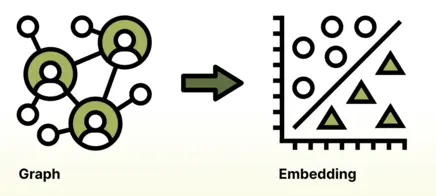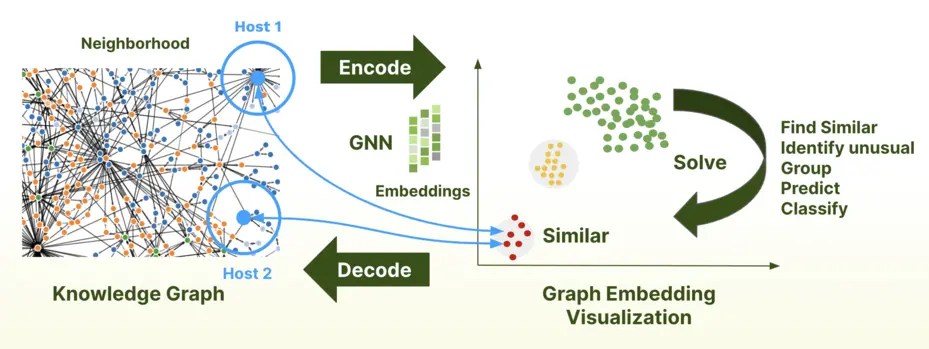ArangoDB GraphML
Boost your machine learning models with graph data using ArangoDB’s advanced GraphML capabilities
ArangoDB Platform
Traditional Machine Learning (ML) overlooks the connections and relationships between data points, which is where graph machine learning excels. However, accessibility to GraphML has been limited to sizable enterprises equipped with specialized teams of data scientists. ArangoDB simplifies the utilization of Graph Machine Learning, enabling a broader range of personas to extract profound insights from their data.
With ArangoDB, you can solve high-computational graph problems using Graph Machine Learning. Apply it on a selected graph to predict connections, get better product recommendations, classify nodes, and perform node embeddings. You can configure and run the whole machine learning flow entirely through the web interface or programmatically.
How GraphML works
Graph machine learning leverages the inherent structure of graph data, where entities (nodes) and their relationships (edges) form a network. Unlike traditional ML, which primarily operates on tabular data, GraphML applies specialized algorithms like Graph Neural Networks (GNNs), node embeddings, and link prediction to uncover complex patterns and insights.
The underlying framework for ArangoDB’s GraphML is GraphSAGE . GraphSAGE (Graph Sample and AggreGatE) is a powerful Graph Neural Network (GNN) framework designed for inductive representation learning on large graphs. It is used to generate low-dimensional vector representations for nodes and is especially useful for graphs that have rich node attribute information. The overall process involves the following steps:
- Graph Construction:
- Raw data is transformed into a graph structure, defining nodes and edges based on real-world relationships.
- Featurization: Your raw graph data is transformed into numerical representations that the model can understand.
- The system iterates over your selected nodes and converts their attributes: booleans become
0or1, numbers are normalized, and text attributes are converted into numerical vectors using sentence transformers. - All of these numerical features are then combined (concatenated).
- Finally, Incremental PCA (Incremental Principal Component Analysis a dimensionality reduction technique) is used to reduce the size of the combined features, which helps remove noise and keep only the most important information.
- The system iterates over your selected nodes and converts their attributes: booleans become
- Training: The model learns from the graph’s structure by sampling and aggregating information from each node’s local neighborhood.
- For each node, GraphSAGE looks at connections up to 2 hops away.
- Specifically, it uniformly samples up to 25 direct neighbors (depth 1) and for each of those, it samples up to 10 of their neighbors (depth 2).
- By aggregating feature information from this sampled neighborhood, the model creates a rich “embedding” for each node that captures both its own features and its role in the graph.
- Inference & Insights:
- The trained model is used to classify nodes, detect anomalies, recommend items, or predict future connections.
ArangoDB streamlines these steps, providing an intuitive and scalable framework to integrate GraphML into various applications, from fraud detection to recommendation systems.


You no longer need to understand the complexities of graph machine learning to benefit from it. Solutions with ArangoDB’s GraphML only require input from a user about their data, and the GraphML managed service handles the rest.
The platform comes preloaded with all the tools needed to prepare your graph for machine learning, high-accuracy training, and persisting predictions back to the database for application use.
What you can do with GraphML
GraphML directly supports two primary machine learning tasks: Node Classification and Node Embeddings.
Node Classification
Node classification is a supervised learning task where the goal is to predict the label of a node based on both its own features and its relationships within the graph. It requires a set of labeled nodes to train a model, which then classifies unlabeled nodes based on learned patterns.
How it works in ArangoDB
- A portion of the nodes in a graph is labeled for training.
- The model learns patterns from both node features and structural relationships (neighboring nodes and connections).
- It predicts labels for unlabeled nodes based on these learned patterns.
Example Use Cases
Fraud Detection in Financial Networks
- Problem: Fraudsters often create multiple accounts or interact within suspicious clusters to evade detection.
- Solution: A transaction graph is built where nodes represent users and edges represent transactions. The model learns patterns from labeled fraudulent and legitimate users, detecting hidden fraud rings based on both user attributes and transaction relationships.
Customer Segmentation in E-Commerce & Social Media
- Problem: Businesses need to categorize customers based on purchasing behavior and engagement.
- Solution: A graph is built where nodes represent customers and edges represent interactions (purchases, reviews, social connections). The model predicts the category of each user based on how similar they are to other users not just by their personal data, but also by how they are connected to others.
Disease Classification in Biomedical Networks
- Problem: Identifying proteins or genes associated with a disease.
- Solution: A protein interaction graph is built where nodes are proteins and edges represent biochemical interactions. The model classifies unknown proteins based on their interactions with known disease-related proteins, rather than just their individual properties.
Node Embedding Generation
Node embedding is an unsupervised learning technique that converts nodes into numerical vector representations, preserving their structural relationships within the graph. Unlike simple feature aggregation, node embeddings capture the influence of neighboring nodes and graph topology, making them powerful for downstream tasks like clustering, anomaly detection, and link prediction. This combination provides valuable insights. Consider using ArangoDB’s Vector Search capabilities to find similar nodes based on their embeddings.
Feature Embeddings versus Node Embeddings
Feature Embeddings are vector representations derived from the attributes or features associated with nodes. These embeddings aim to capture the inherent characteristics of the data. For example, in a social network, a feature embedding might encode user attributes like age, location, and interests. Techniques like Word2Vec, TF-IDF, or autoencoders are commonly used to generate such embeddings.
In the context of graphs, Node Embeddings are a combination of a node’s feature embedding and the structural information from its connected edges. Essentially, they aggregate both the node’s attributes and the connectivity patterns within the graph. This fusion helps capture not only the individual properties of a node but also its position and role within the network.
How it works in ArangoDB
- The model learns an embedding (a vector representation) for each node based on its position within the graph and its connections.
- It does not rely on labeled data – instead, it captures structural patterns through graph traversal and aggregation of neighbor information.
- These embeddings can be used for similarity searches, clustering, and predictive tasks.
Example Use Cases
Recommendation Systems (E-commerce & Streaming Platforms)
- Problem: Platforms like Amazon, Netflix, and Spotify need to recommend products, movies, or songs.
- Solution: A user-item interaction graph is built where nodes are users and products, and edges represent interactions (purchases, ratings, listens). Embeddings encode relationships, allowing the system to recommend similar items based on user behavior and network influence rather than just individual preferences.
Anomaly Detection in Cybersecurity & Finance
- Problem: Detecting unusual activity (e.g., cyber attacks, money laundering) in complex networks.
- Solution: A network of IP addresses, users, and transactions is represented as a graph. Nodes with embeddings that significantly deviate from normal patterns are flagged as potential threats. The key advantage here is that anomalies are detected based on network structure, not just individual activity logs.
Link Prediction (Social & Knowledge Graphs)
- Problem: Predicting new relationships, such as suggesting friends on social media or forecasting research paper citations.
- Solution: A social network graph is created where nodes are users, and edges represent friendships. Embeddings capture the likelihood of connections forming based on shared neighborhoods and structural similarities, even if users have never interacted before.
Key Differences
| Feature | Node Classification | Node Embedding Generation |
|---|---|---|
| Learning Type | Supervised | Unsupervised |
| Input Data | Labeled nodes | Graph structure & features |
| Output | Predicted labels | Node embeddings (vectors) |
| Key Advantage | Learns labels based on node connections and attributes | Learns structural patterns and node relationships |
| Use Cases | Fraud detection, customer segmentation, disease classification | Recommendations, anomaly detection, link prediction |
GraphML provides the infrastructure to efficiently train and apply these models, helping users extract meaningful insights from complex graph data.
Metrics and Compliance
GraphML supports tracking your ML pipeline by storing all relevant metadata and metrics in a Graph called ArangoPipe. This is only available to you and is never viewable by ArangoDB. This metadata graph links all experiments to the source data, feature generation activities, training runs, and prediction jobs, allowing you to track the entire ML pipeline without having to leave ArangoDB.
Security
Each deployment that uses GraphML has an arangopipe database created,
which houses all ML Metadata information. Since this data lives within the deployment,
it benefits from the ArangoGraph security features and SOC 2 compliance.
All GraphML services live alongside the ArangoGraph deployment and are only
accessible within that organization.

